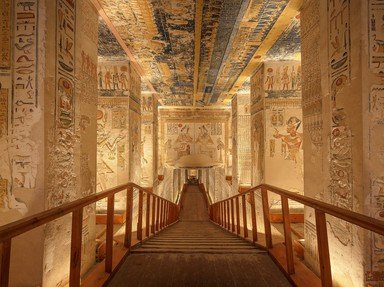Quiz Answer Key and Fun Facts
1. Perhaps the insect most associated with ancient Egypt is the scarab beetle. What were these beetles strongly associated with, as a result of their habit of rolling large balls of dung using their hind legs?
2. Another significant insect in ancient Egypt was the buprestid beetle, which features in many tomb engravings and jewellery designs. What was the alternate, rather fitting, name given to this beetle?
3. Whilst locusts perhaps carry more negative connotations in ancient Egypt, which related insect is seen as a delicate and beautiful symbol and was found on the toilet box of King Tutankhamen?
4. After death, the heart of an Egyptian was wrapped in cloth with a large scarab beetle amulet (called a "heart scarab"). What traditionally happened to the other vital organs?
5. Many in ancient Egypt believed the god, Sepa, to be capable of healing stings and bites. What creepy-crawly was Sepa commonly depicted as?
6. Widespread and recognised universally as one of the most fearsome insects, which invertebrate was found during a dig in Deir el-Medina in 1929, mummified and within a tiny casket?
7. Thoth freed this goddess who had been taken prisoner by Seth, and provided seven scorpions for her protection. What was her name?
8. Because bees and scorpions are "stinging animals", how were they often depicted in ancient Egyptian amulets/engravings?
9. "Heart scarabs" were said to prevent the deceased from confessing their sins in a trial which was to be held in front of the gods. What was this trial known as?
10. Another insect which featured in burial rituals of ancient Egypt was the common fly. What did the ancient Egyptians think that flies represented?
Source: Author
doublemm
This quiz was reviewed by FunTrivia editor
CellarDoor before going online.
Any errors found in FunTrivia content are routinely corrected through our feedback system.

